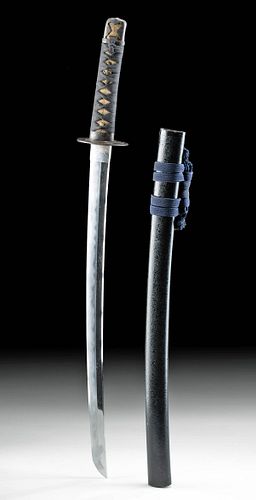Signed 1650s Japanese Edo Wakizashi by Bishu Osafune
About Seller
686 S Taylor Ave, Ste 106
Louisville, CO 80027
United States
Selling antiquities, ancient and ethnographic art online since 1993, Artemis Gallery specializes in Classical Antiquities (Egyptian, Greek, Roman, Near Eastern), Asian, Pre-Columbian, African / Tribal / Oceanographic art. Our extensive inventory includes pottery, stone, metal, wood, glass and textil...Read more
Two ways to bid:
- Leave a max absentee bid and the platform will bid on your behalf up to your maximum bid during the live auction.
- Bid live during the auction and your bids will be submitted real-time to the auctioneer.
Bid Increments
| Price | Bid Increment |
|---|---|
| $0 | $25 |
| $300 | $50 |
| $1,000 | $100 |
| $2,000 | $250 |
| $5,000 | $500 |
| $10,000 | $1,000 |
| $20,000 | $2,500 |
| $50,000 | $5,000 |
| $100,000 | $10,000 |
| $200,000 | $20,000 |
About Auction
Nov 10, 2022
Museum-worthy examples of classical antiquities (Egyptian, Greek, Roman, Near Eastern), Viking, Far East / Asian, Pre-Columbian, African / Tribal, Oceanic, Native American, Spanish Colonial, Nautical, Fossils, Ancient Jewelry, Fine / Visual Arts, so much more! Artemis Fine Arts info@artemisfinearts.com
- Lot Description
East Asia, Japan, early Edo Period, ca. mid-17th century, signed "Bishu Osafune" on tang. A forged steel wakizashi blade of elegant shinogi-zukuri form bearing a diamond-shaped (iori-mune) profile and the signature of swordsmith Bishu Osafune on one side of the tang. The wavy temper line (gunome-choji) is formed by the tight hammer-folded graining (itame-hada) and bears an attractive tobiyaki pattern with deep tempering at the point. The handle (tsuka) is fitted with stingray skin (samegawa), avian-form ornaments (menuki) shaped from shakudo, and a shakudo-inlaid iron cap. The circular iron hand guard (marugata tsuba) features intricate openwork decorations (sukashi) as well as pairs of kanji - the top pair translates to "bravery" and the bottom pair to "decisiveness." The scabbard (saya) is covered in black lacquer (urushi) and bound with a modern cotton strap. Size (w/ scabbard): 3" W x 28.5" H (7.6 cm x 72.4 cm); (blade): 20.125" L x 1.125" W (51.1 cm x 2.9 cm)
This traditional Japanese sword was both a weapon and a symbol of authority and social status. The wakizashi paired with the longer katana sword marked the wearer as a samurai. The shorter sword was seen as an auxiliary weapon, also used for fighting in close quarters. Wakizashi could also be worn by non-samurai if worn alone, and members of the merchant class (chonin) wore them because of the frequency of encountering bandits when traveling between Japan's cities.
Over the centuries that katana and wakizashi were made, the process of their manufacture became heavily regulated. For example, in 1683, the Tokugawa Shogunate made laws concerning the maximum size of katana and wakizashi. Meanwhile, once a samurai took ownership of his new weapon, he had to wear it in a highly regulated manner. Wakizashi and katana in this period were both deadly weapons and signs of prestige. The craftsmanship of this piece is evident and reflects hundreds of hours of work.
Provenance: private Jones collection, Boulder, Colorado, USA; ex-private Sacramento, California, USA collection
All items legal to buy/sell under U.S. Statute covering cultural patrimony Code 2600, CHAPTER 14, and are guaranteed to be as described or your money back.
A Certificate of Authenticity will accompany all winning bids.
We ship worldwide and handle all shipping in-house for your convenience.
#175625Scabbard is perhaps a later replacement, and knotted cotton cord is modern. Minor abrasions to blade, handle, hand guard, and scabbard, with minor wear to handle bindings and shakudo cap inlays, otherwise in excellent condition. Modern fabric carrying case included.Condition
- Shipping Info
-
Artemis Gallery will no longer be able to offer in-house shipping for most international orders, as well as all oversized orders, including most paintings. These items are clearly marked in the listing as “3rd Party Shipping Required” in the listing. We have a list of recommended third party shippers to assist you in shipping to and from, and would be happy to assist you in working with them. We require a written authorization from the client to release property to any third party. You may fax a Shipping Release Form to 303-828-3235 or email your authorization to kristen@artemisgallery.com. Please note the all property must be removed from our premises within seven (7) business days following the last day of the auction.
-
- Buyer's Premium



 EUR
EUR CAD
CAD AUD
AUD GBP
GBP MXN
MXN HKD
HKD CNY
CNY MYR
MYR SEK
SEK SGD
SGD CHF
CHF THB
THB
















